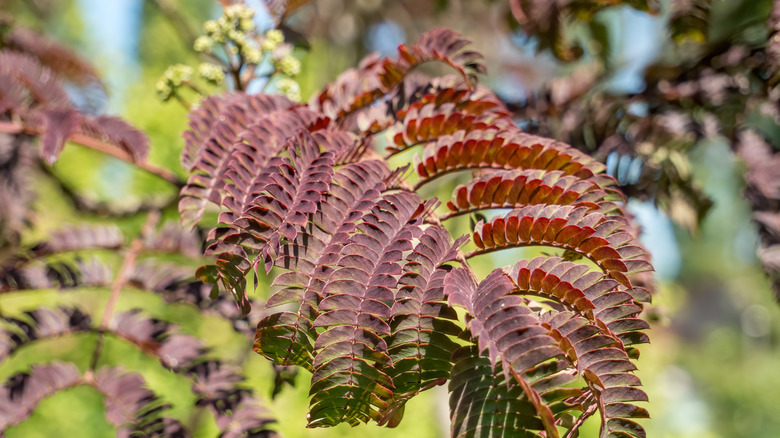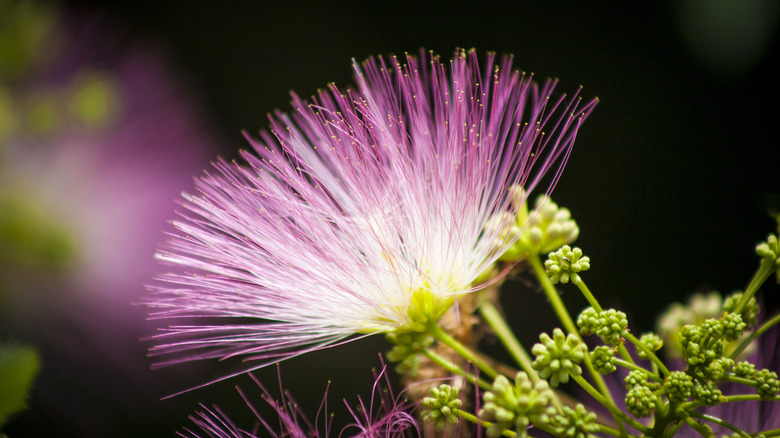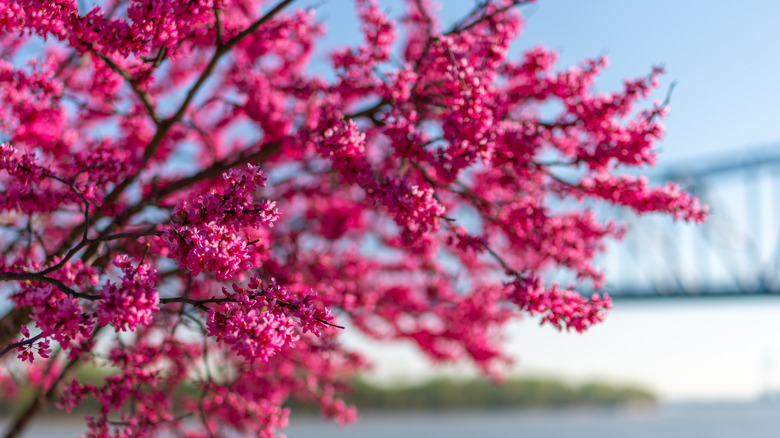Why You Should Reconsider Planting A Chocolate Mimosa Tree To Attract Hummingbirds
A chocolate mimosa sounds more like a decadent brunch beverage than a trendy, fuchsia-flowered tree. But if you're looking for trees with pink flowers to grow in your yard, you might want to cross the chocolate mimosa off your invite list. The tree's lacy leaves and pink pom-pom flowers may look like they belong in a brunch table centerpiece, but these fast-growing prolific seeders often escape into the wild, where they spread quicker than juicy gossip among brunching besties.
Beloved for its showy, fragrant flowers and uniquely colored foliage, chocolate mimosa (Albizia julibrissin 'Summer Chocolate') is a cultivar of the Asian mimosa or silk tree. These deciduous trees grow 20 to 40 feet tall and have smooth, light brown bark and bronze-green, fern-like leaves that become deep burgundy as they mature. In late spring to early summer, they produce bright pink, pom-pom flowers, which are followed by large yellow-brown seed pods. The trees' flowers are hummingbird hotspots. Like brunch-goers, these diminutive drinkers love mimosas and often stop for a nip of nectar. Bees and butterflies also frequent these popular pit stops.
But don't let their beautiful blooms beguile you. Like too many bubbly brunchtime cocktails, these invasive trees cause some serious headaches.
Why chocolate mimosa trees are problematic
If trees were brunch guests, chocolate mimosas would be buffet bullies who cut in line to get seconds and thirds before you fill your first plate. These resource-hogging trees have invaded natural areas across much of the United States, forming dense stands that limit the sunlight available to native plants. Prolific seeders, mimosa trees are particularly problematic near stream banks and floodplains, where water carries their seeds to distant locations. Their tolerance for many soil types means these trees grow just about anywhere — from roadsides to vacant lots. It's no wonder mimosas are listed as invasive species in several states.
If its bullying behavior doesn't convince you to rethink growing a mimosa tree in your yard, perhaps its other problematic traits will change your mind. For starters, the tree's pink pom-poms and lacy leaflets litter the ground, and its weak, brittle branches snap off in strong winds. But the quick-sprouting seeds are the real nightmare. Each seed pod carries 5 to 10 seeds, meaning 5 to 10 potential new trees. Multiply that by the number of pods on the tree, and you get an idea of how many seedlings you'll be pulling up each year. And if you decide to cut the tree out of your life, it won't go down without a fight. These tenacious trees can resprout from root and stump suckers. Mimosa trees are also prone to diseases like fusarium wilt, a lethal fungal disease that interferes with the transport of water inside the tree.
What to plant instead of chocolate mimosa trees
Fortunately, there are plenty of pretty trees with less troublesome traits than the chocolate mimosa. Native trees are best for attracting hummingbirds since they are adapted to local soils and climates. Plus, hummingbirds often prefer them. The Audubon Native Plants Database can help you locate hummingbird-friendly trees in your region.
Desert willow (Chilopsis linearis) is one alternative. Although this smallish tree lacks the purple foliage of chocolate mimosa, it sports delicate leaves and frilly, trumpet-shaped flowers. Native to the southwestern U.S., this relative of the trumpet creeper grows 15 to 40 feet tall. Its violet-scented, pink to purple flowers emerge in mid- to late spring, and the seeds from its cigar-shaped seedpods attract birds in the fall. These trees are drought tolerant, fast growing, and resistant to pests and diseases. Desert willows self-seed and can become weedy, but there are many cultivars, including seedless types.
Eastern redbud (Cercis canadensis) is another vibrant tree that will bring stunning color to your spring landscape. Found across the eastern half of the U.S., this deciduous tree grows 20 to 30 feet high. In early spring, its bare branches burst with white or pink blooms that attract hummingbirds. The flowers are followed by pea-like pods and heart-shaped, reddish-green leaves that turn darker green as they mature. Several redbud cultivars are available, including some with deep burgundy leaves. With these and many other showy, low-maintenance options available, why not choose a less invasive tree and save the chocolate mimosas for brunch?


